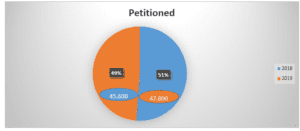Statistics on Population of Juvenile Delinquents
Data Visualization


Executive Summary
The figures above show the difference in the frequency of non-petitioned cases among age 15 or younger offenders. In 2018, the total number of non-petitioned cases was 74,000 and 47,800 petitioned cases, while in 2019, the total of non-petitioned cases was 72,000, and petitioned cases were 45,600(National Center for Juvenile Justice, 2019). This explains the variance in percentage. The data indicates that there was a decline in delinquency cases in 2019, with the highest drop being in the number of petitioned cases since the difference was 2,200 while the difference in non-petitioned cases was 2,000. The difference in the numbers means that juvenile sentencing in courts was more strict in 2019 compared to 2018, thus deterring juvenile crime. Our assignment help will hone your writing prowess for papers that will awe your professors.
Juvenile delinquency has become prevalent in most societies as offenders aged between 15 to 17 years engage in criminal activities. In some instances, some offenders charged at the juvenile sentencing courts are below 15 years. Types of offenses that come under acts of delinquency and status offenses in juvenile courts are truancy, curfew violations, runaways, ungovernable youth, and underage drinking. The most prevalent among these crimes is underage drinking. A survey conducted by the Substance Abuse and Mental Health Services Administration in 2013 indicated that 1.7 million young people are classified as heavy drinkers consuming up to five or more drinks in one sitting on 5 days or more over a period of one month. Youths who are found drinking are petitioned as status offenders. One of the steps in the court process is an arraignment hearing. The court personnel involved in this step are the judge and the offender’s lawyer. The second step is the pre-trial hearing which involves the judge and the offender’s lawyer. The third step is trial. This step also involves a judge and the offender’s lawyer, but in some instances, a jury may be involved when the offender requests a jury trial. The final step is the disposition hearing, where the judge could impose fines on the offender, issue a warning, and rule that the offender should undergo community service. Foster care, probation, detention, or out-of-home placement. This step only includes the judge.
References
National Center for Juvenile Justice. (2019). Easy access to juvenile court statistics. https://www.ojjdp.gov/ojstatbb/ezajcs/
Substance Abuse and Mental Health Services Administration (2013). Results from the 2012 National Survey on Drug Use and Health: Summary of National Findings. NSDUH Series H-46, HHS Publication No. (SMA) 13-4795. Rockville, Md.: Author.
ORDER A PLAGIARISM-FREE PAPER HERE
We’ll write everything from scratch
Question 
access information from Easy Access to Juvenile Court Statistics (EZAJCS)
Write a report that consists of 2 parts:
How do one year’s delinquency case totals compare to another year’s totals based on the age at referral, manner of handling, and disposition? make a circle chart to show a comparison

Statistics on Population of Juvenile Delinquents
Create an image for your data visualization using an illustration tool in Microsoft® Word or PowerPoint®, or use an online drawing tool such as Piktochart® or Smore.
Part 2: Executive Summary
Write an executive summary of your findings in 250 to 525 words. Complete the following in your summary:
Explain the data shown in your image. Summarize what the difference in the numbers means for juvenile sentencing in courts.
Categorize the types of offenses that come under acts of delinquency and status offenses in juvenile courts.
Describe in detail the court process applicable for either type of offense and the court personnel associated with each process.